Uneven floors can be a frustrating challenge for homeowners and property owners alike.
Whether it’s a minor slope or a significant incline, an uneven concrete floor not only affects the aesthetics of a space but can also pose potential safety hazards.
Fortunately, with the right knowledge and a little bit of effort, it is possible to level a concrete floor that slopes and restore it to a smooth and even surface.
It is essential to achieve a level floor in a basement in order to make the most of it. The good news is that leveling uneven concrete slabs is a simple process that doesn’t sacrifice headroom.
Learn how to level concrete floors with these tips and a step-by-step guide.
The Easiest Way To Level A Sloping Floor
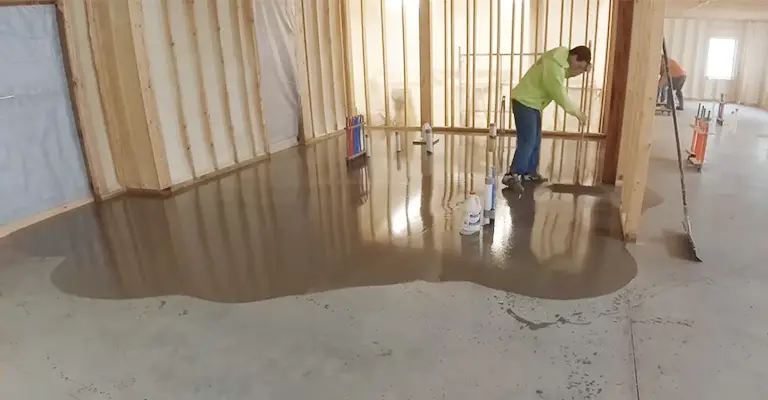
Self-levelling compounds, liquid underlayments or floor resurfaces are the easiest way to level floors within level-cut rails.
The material flows out like thick syrup in less than an hour, sometimes even less, then hardens into a smooth, perfectly level surface. There will only be a small amount of headroom lost at the slab’s low points.
Because gypsum is susceptible to moisture, you should use a Portland cement compound for basements. Clean the existing slab thoroughly with a degreaser before pouring to ensure a strong bond.
Step-by-Step Instructions for Leveling a Concrete Floor
- A 2×4 wooden rail, positioned at one end on the high point in the room, is the best way to resurface an uneven concrete slab.
- Shim the rail until it is perfectly level, then transfer the unevenness of the floor onto the rail with a scribing tool.
- Trace the uneven contour of the slab by matching the bottom of the scribe to the floor surface.
- Using a circular saw to cut the rail after scribing the line.
- The scribed 2×4 rail should be leveled after being placed back on the floor. You may need to scribe and cut it again if necessary.
- Apply construction adhesive to the scribed rail and secure it to the slab.
- Use a hammer drill equipped with a carbide-tipped masonry bit to drill pilot holes through the rail and into the concrete. The rail should be pre-bored to prevent splitting.
- Lay a second 24 rail across the floor, setting one end on top of the first, and fasten it to the slab using masonry nails.
- Adjust the scribing tool to the height of the second rail after leveling the second rail with the first.
- Using the scribing tool, mark a short reference line on the second rail and stretch the legs so that they span from the floor to the reference mark.
- To transfer unevenness to the second rail, guide the scribing tool along the floor.
- Using the same trimming method as the first rail, install the second rail, then cut a third 2×4 rail that spans the two already in place.
- Under one end of the third rail, adjust the scribing tool to the height of the rail.
- On the third rail, draw a reference line that stretches from the floor to the reference mark, then adjust the scribing tool accordingly.
- The third rail is cut and installed just like the first two, following the floor line with the scribing tool.
- To stir with a bucket of leveling compound, use a drill with a mixing paddle of 12 inches. There should be a thick batter-like consistency to the mixture.
- Fill the rail perimeter with leveling compound slowly. After overfilling them, use a screed made from a 6-inch-wide straight-edged board to remove the excess compound. Surfaces will be smooth and even as a result.
- Once the leveling compound has cured, repeat the process in other parts of the room as needed to ensure the floor is level. If you will be installing flooring over the resurfaced slab, make sure the compound is properly dry according to the installation instructions.
Skilled professionals usually recommend a poly jacking or underpinning method to level-sloping concrete floors. Unlike other solutions, these solutions actually solve the problem without contributing to further problems.
Why Is The Concrete Floor Sloping?
The first question you need to answer if you want to level a sloped concrete floor is: Why is the floor sloping?
Does the sloping floor result from improperly poured concrete or from foundation settlement? To level a concrete floor that slopes, the answer to this question is crucial.
Whenever a concrete floor, or any floor, slants due to differential settlement, foundation repair is required. Thus, it’s not the concrete that’s the problem.
In that case, don’t mistakenly think that the problem is with the concrete floor but with the building’s foundation. It is common for a sloped floor to indicate differential foundation settlement.
What Is Differential Settlement And Why Does It Cause Sloping Floors?
When a structure’s foundation settles unevenly into the soil, it is called differential foundation settlement.
All structures will inevitably settle into the soil after they are built. The settlement isn’t a problem as long as it is uniform. The differential settlement, on the other hand, is a different story.
As a result of uneven foundation settlement, everything is out of plumb, causing the foundation to be stressed.
A sloped floor, cracks in the wall, floor, or ceiling, stair step cracks in brickwork, and locked doors and windows are common signs.
Voids in Polyjacking Concrete Floors
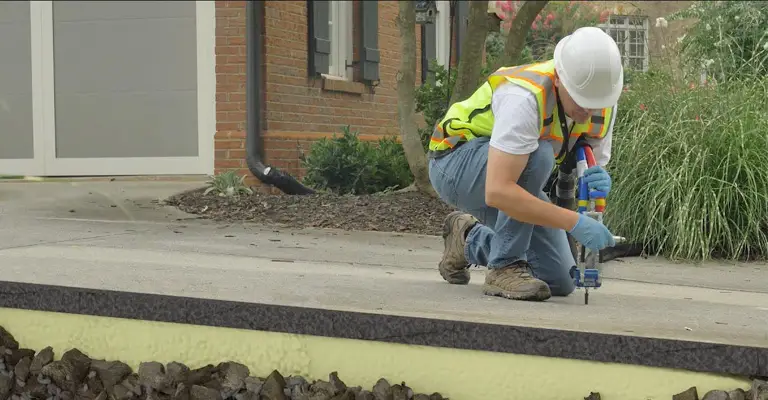
A void beneath your slab can cause some concrete floors to slope. The space between the soil particles could have formed if the soil wasn’t compacted properly.
The soil under your home can be washed out by wastewater if a sewer pipe breaks under the slab. Among the other causes are poor drainage, expansive soil, and others.
There may be sloping in the middle of the room if there is a void under your concrete floor (slab). Polyjacking will be used in this situation to fill the void and level your floor. The process is as follows.
- Concrete sloping sections are drilled with small holes.
- The void below is filled with polyurethane foam injected through the holes.
- Your concrete floor is leveled as the foam fills the void.
- Before driving or walking on the concrete floor, wait 15 minutes for the foam to cure.
In addition to being cost-effective, polyjacking is also permanent. Interior concrete floors can only be polyjacked with foam due to its weight.
Foam will need to be used more if the void below your concrete floor is very large. The cost of the repair may increase as a result.
Underpinning Concrete Floors – Settlement
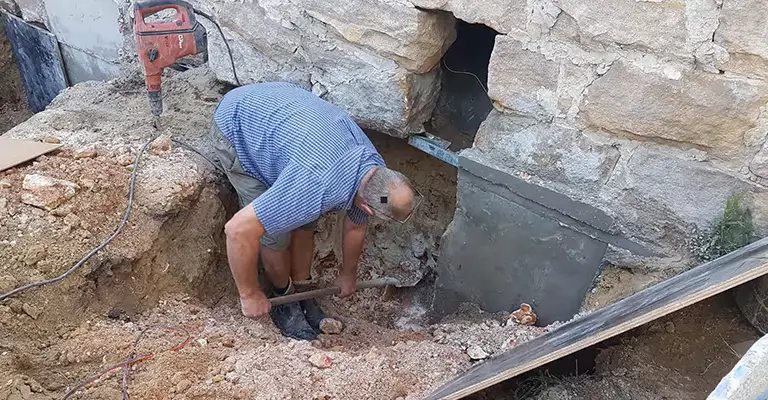
There are several causes of this problem, including soil that has been improperly compacted, clay-filled, washed away, saturated with moisture, or affected by a natural disaster.
In the event that your concrete floor slopes upward toward one end, there is a possibility that that part of your foundation is sinking into the ground.
Within seven years of construction, most homes experience some form of settlement. Typically, foundations won’t move again for 250 years after seven years without outside disturbance.
The underpinning process corrects extreme settlements:
- To correct the settlement of your home, professionals determine which sections need to be lifted. Elevation measurements are usually used to identify this.
- Using standard distance measurements, professionals plan how many piers are needed once the settling section has been identified. How many piers are needed usually determines the cost of underpinning.
- The footers of your foundation are exposed by digging pits around your foundation.
- A foundation footer anchors the piers, which are drilled or pushed into the soil below depending on the type of pier used.
- Using hydraulic jacks, your foundation will be raised to the maximum practical level once the piers have reached load-bearing soil.
- Backfilling and rough grading are done after the pits have been backfilled.
- In less than a day, underpinning can level settling foundations. During this process, cracks caused by settlement can also be repaired.
Don’t Use Self-Leveling Compound If The Problem Is Settlement
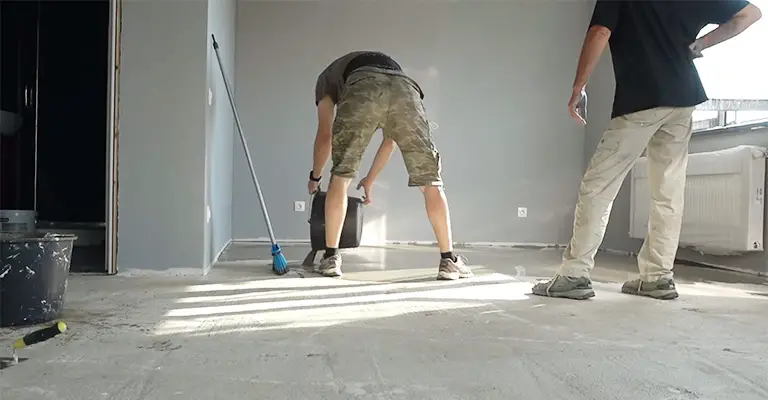
Self-leveling compounds are often recommended in “how-to” articles for leveling a sloped concrete floor. If the concrete itself is the problem with the floor, then this could work.
In the case of improper pouring, for example. Using self-leveling compound on a concrete floor that slopes due to foundation settlement is not a good idea.
In spite of your best efforts, your concrete repair will not last long because the problem lies with the foundation, not the concrete. Before doing anything else, you should always find out why a concrete floor slopes.
Signs A Home Might Be Experiencing Differential Settlement
Differential foundation settlement can be detected by, but is not limited to, the following signs:
- Separating moldings from walls or ceilings
- Brick or masonry cracks on stairs
- A wall or ceiling that has separated from the wall
- The wallpaper may be torn (this could indicate a crack in the wall behind the wallpaper.)
- Having trouble opening and closing doors and windows
- A leaning chimney or porch
- Cracks in the ceiling
- Cracks in the floor
- Cracks in the wall
Why Do Foundations Settle?
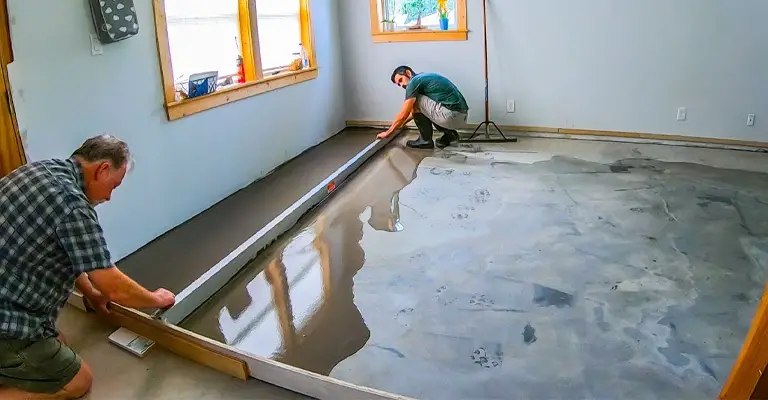
Differential settlement of foundations can be caused by a variety of factors, including:
Natural disasters – such as earthquakes, floods, tornadoes, etc. – can cause foundation settlement.
Excavation close to a foundation – Excavation close to a foundation can destabilize the soil under the building’s foundation, causing differential settlement.
Weather changes – Consider building a foundation during the dry season on expansive soil. When the wet season returns, what will happen? Under the foundation, the soil will expand.
Problems related to expansive soil – Clay-rich soil swells when it absorbs water and shrinks when it dries. It is called expansive soil because it swells when it absorbs water.
Under the foundation, this swelling-shrinking cycle – which is usually seasonal – causes movement. As a result, differential settlement can occur over time.
Insufficiently compacted soil – Before building on top of soiled soil, it must be tamped down. Structures built without this step settle unevenly into the soil after they are built, resulting in differential settlements.
Importance Of Hiring A Professional To Level A Concrete Floor That Slopes Due To Differential Settlement
Leveling a concrete floor that slopes due to differential settlement is a complex task that often requires the expertise of a professional. Here are a few reasons why seeking professional assistance for this specific issue is highly recommended:
1. Expertise and Experience: Professionals specializing in concrete leveling have extensive knowledge and experience in dealing with various types of floor leveling projects.
They are familiar with the intricacies involved in identifying the underlying causes of differential settlement and have the necessary skills to address the problem effectively.
2. Proper Assessment: A professional will conduct a thorough assessment of the sloping concrete floor to determine the extent of the differential settlement and identify any potential underlying issues.
This evaluation is crucial in developing an appropriate action plan and ensuring the floor’s long-term stability.
3. Specialized Equipment: Leveling a concrete floor affected by differential settlement often requires specialized equipment such as hydraulic jacks, slab lifters, or laser leveling systems.
These tools are typically not readily available to homeowners and require professional expertise for safe and accurate usage.
4. Structural Considerations: In cases of severe differential settlement, there may be underlying structural issues that need to be addressed.
Professionals are trained to recognize these concerns and can provide appropriate recommendations or coordinate with other experts, such as structural engineers, if necessary.
5. Time and Cost Efficiency: Hiring a professional can save you significant time and effort. They have the knowledge, skills, and resources to complete the job efficiently, minimizing disruptions to your daily life.
Additionally, their expertise can help prevent costly mistakes that may arise from DIY attempts.
The Bottom Line
When it comes to dealing with a sloping concrete floor caused by differential settlement, it’s advisable to consult and engage a professional contractor or a concrete leveling company.
They will provide you with the most accurate assessment, recommend appropriate solutions, and execute the leveling process with precision, ensuring a durable and level surface for your space.








